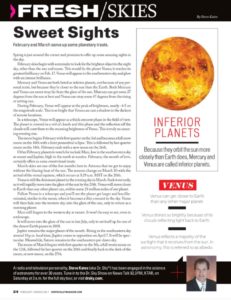February and March serve up some planetary treats
February and March serve up some planetary treats.
By Steve Kates
Spring is just around the corner and promises to offer up some amazing sights in the sky.
February skies begin with a reminder to look for the brightest object in the night sky, other than the sun and moon. This would be the planet Venus; it reaches its greatest brilliancy on Feb. 17. Venus will appear in the southwestern sky and glow with an intense brilliance.
Mercury and Venus are both listed as inferior planets, not because of any personal traits, but because they’re closer to the sun than the Earth. Both Mercury and Venus can never stray far from the glare of the sun. Mercury can get some 27 degrees from the sun at best and Venus can stray some 47 degrees from the rising or setting sun.
During February, Venus will appear at the peak of brightness, nearly -4.5 on the magnitude scale. This is so bright that Venus can cast a shadow in the darkest of remote locations.
In a telescope, Venus will appear as a thick crescent phase in the field of view. The planet is covered in a veil of clouds and this phase and the reflection off the clouds will contribute to the stunning brightness of Venus. This is truly an amazing evening star.
The moon begins February with first quarter on the 3rd and becomes a full snow moon on the 10th with a faint penumbral eclipse. This is followed by last quarter moon on the 18th. February ends with a new moon on the 26th.
Other February planets to watch for include Mars, low in the southwestern sky at sunset and Jupiter, high in the south at sunrise. February, the month of love, certainly offers us some sweet visual treats.
March skies are one of the few months here in Arizona that we get to enjoy without theblazing heat of the sun. The seasons change on March 20 with the arrival of the vernal equinox, which occurs at 3:29 a.m. MST on the 20th.
Venus is still the dominant planet in the evening sky in March. Seek it out early, as it will rapidly move into the glare of the sun by the 25th. Venus will move closer to Earth than any other planet can, within some 25 million miles of our planet.
Follow Venus in a telescope and you’ll see the planet get larger and less illuminated, similar to the moon, when it becomes a thin crescent in the sky. Venus will then fade into the western sky, into the glare of the sun, only to return as a morning planet.
Mars still lingers in the western sky at sunset. It won’t be easy to see, even in a telescope. It will move into the glare of the sun in late July, only to set itself up for one of the closest Earth passes in 2018.
Jupiter remains the major planet of the month. Rising in the southeastern sky around 10 p.m. local time, Jupiter comes to opposition on April 7. It will be spectacular. Meanwhile, Saturn remains in the southeastern pre-dawn sky.
The moon of March begins with first quarter on the 5th, a full worm moon on the 12th, followed by last quarter on the 20th and finally back to the dark of the moon, or new moon, on the 27th.
Inferior Planets
Because they orbit the sun more closely than Earth does, Mercury and Venus are called inferior planets.
VENUS
- Venus can get closer to Earth than any other major planet.
- Venus shines so brightly because of its clouds reflecting light back to Earth.
- Venus reflects a majority of the sunlight that it receives from the sun. In astronomy, this is referred to as albedo.
EQUINOX
The equinox is the time or date at which the sun crosses the celestial equator, when day and night are of equal length.
There are two equinoxes on Earth: the vernal (spring) equinox in March and the autumnal (fall) equinox in September.
Related posts
Leave a Comment
You must be logged in to post a comment.







